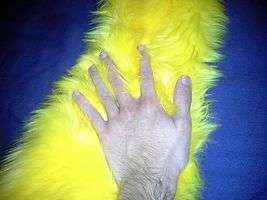Stimming

Self-stimulatory behavior, also known as stimming[1] and self-stimulation,[2] is the repetition of physical movements, sounds, or words, or the repetitive movement of objects common in individuals with developmental disabilities and most prevalent in people with autism spectrum disorders.[2][3] It is also commonly seen in people with anxiety disorders such as obsessive–compulsive disorder, ADHD, and Tourette syndrome, and in people with neurological disorders or brain infections.[4][5] It is considered a protective response to over-stimulation, in which people calm themselves by blocking less predictable environmental stimuli, to which they have a heightened sensitivity.[2][6] Sensory processing disorder is also given as a reason by some therapists for the behavior.[6] Another theory is that stimming is a way to relieve anxiety and other emotions.[7]
Common stimming behaviors (sometimes called stims[8]) include hand flapping, rocking, excessive or hard blinking, pacing, head banging, repeating noises or words, snapping fingers, and spinning objects.[9][10] Stimming is almost always present in autism, but does not necessarily indicate its presence.[11] The biggest difference between autistic and non-autistic stimming is in the type of stim and the quantity of stimming.[11] When the need to stim or the amount of stimming interferes with normal behavior, it becomes diagnosable as autism, Asperger's or SPD (not recognized in the Diagnostic and Statistical Manual of Mental Disorders).
In the Diagnostic and Statistical Manual of Mental Disorders, published by the American Psychiatric Association, this type of behavior is described as "stereotyped and repetitive motor mannerisms" and listed as one of the symptoms of autism.[12] There are numerous ways to reduce or eliminate stereotypic behaviors, including providing alternative forms of stimulation and the use of medication (however, it is not clear whether medication is actually beneficial or restricts the individual from finding relief).[3]
The majority of the autistic community opposes attempts to reduce or eliminate stimming, as it is an important tool for self-regulation.[13][14][15] Many contend that attempts to stop people from stimming are potentially abusive. [16][17][18][19]
Stimming can sometimes be self-injurious, such as when it involves head-banging, hand-biting, and excessive self-rubbing and scratching.[20] However, viewed through the lens of SPD and autism, these behaviours can be seen as an adaptive response to over- and underwhelming interpretation of sensory stimuli
Stimming can sometimes be mistaken for a sign of drug abuse.[21][22]
See also
References
- ↑ Rosalind Bergemann (2013). An Asperger Leader's Guide to Living and Leading Change. Jessica Kingsley Publishers. ISBN 9780857008725.
- 1 2 3 Valerie Foley (2011). The Autism Experience. ReadHowYouWant.com. ISBN 9781458797285.
- 1 2 Stephen M. Edelson, Ph.D. "Self-Stimulatory Behavior". Autism Research Institute.
- ↑ "Is Stimming Always Autism? | LoveToKnow". LoveToKnow. Retrieved 2018-03-23.
- ↑ Insights, TMI: Tourette Mama (2017-09-16). "Stimming, Tics & ADHD: The More You Know". TMI: Tourette Mama Insights. Retrieved 2018-03-23.
- 1 2 Gretchen Mertz Cowell (2004). Help for the Child with Asperger's Syndrome: A Parent's Guide to Negotiating the Social Service Maze. Jessica Kingsley Publishers. ISBN 9781846420429.
- ↑ Eileen Bailey (15 July 2011). "Autism Spectrum Disorders and Anxiety". Health Central. Retrieved 25 March 2014.
- ↑ Temple Grandin, PhD (November–December 2011). "Why Do Kids with Autism Stim?". Autism Digest. Archived from the original on 31 March 2014. Retrieved 25 March 2014.
- ↑ Eileen Bailey (27 August 2012). "Stimming". Health Central. Retrieved 25 March 2014.
- ↑ "Stimming: What autistic people do to feel calmer". BBC. 5 June 2013. Retrieved 25 March 2014.
- 1 2 Lisa Jo Rudy (13 October 2009). "Stimming". About.com. Retrieved 24 March 2014.
- ↑ “Autism Spectrum Disorders”, 1994, Diagnostic and Statistical Manual, American Psychiatric Association
- ↑ "Autism and Stimming" (PDF). Autism West Midlands. Archived from the original (PDF) on 2015-06-07.
- ↑ "Meet the company that's making jewelry for adults with autism | The Daily Dot". The Daily Dot. 2016-07-20. Retrieved 2017-10-01.
- ↑ "On Stimming and why "quiet hands"ing an Autistic person is wrong". The Caffeinated Autistic. 2013-02-10. Retrieved 2017-10-01.
- ↑ DeVita-Raeburn, Elizabeth. "Is the Most Common Therapy for Autism Cruel?". The Atlantic. Retrieved 2017-10-01.
- ↑ "My Thoughts on ABA - Autism Women's Network". Autism Women's Network. 2015-02-11. Retrieved 2017-10-01.
- ↑ "The controversy over autism's most common therapy | Spectrum | Autism Research News". Spectrum | Autism Research News. 2016-08-10. Retrieved 2017-10-01.
- ↑ "I Abused Children And SO DO YOU: A Response To An ABA Apologist". Diary Of A Birdmad girl. 2017-04-25. Retrieved 2017-10-01.
- ↑ Stephen M. Edelson, Ph.D. "Self-Injurious Behavior". Autism Research Institute. Retrieved 29 March 2014.
- ↑ "Family of teen with autism mistakenly tackled by police calls for better training". CBS News. September 21, 2017. Retrieved 14 September 2018.
- ↑ Victoria Albert (7 June 2018). "Cop Thought It Was Drugs. It Was a Teen Coping With Autism: Lawsuit". The Daily Beast. Retrieved 14 September 2018.